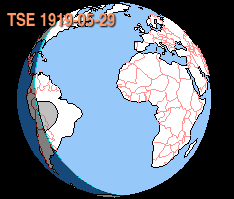Solar eclipse of May 29, 1919
| Solar eclipse of May 29, 1919 | |
|---|---|
 Animation of the total solar eclipse of May 29, 1919 |
|
| classification | |
| Type | Total |
| area |
South America , Central America , Africa Total: Chile , Peru , Bolivia , Brazil , Central Africa |
| Saros cycle | 136 (32 of 71) |
| Gamma value | −0.2955 |
| Greatest eclipse | |
| Duration | 6 minutes 51 seconds |
| place | North Atlantic near Liberia |
| location | 4 ° 24 ′ N , 16 ° 42 ′ W |
| time | May 29, 1919 1:08:55 PM UT |
| size | 1.0719 |
The total solar eclipse of May 29, 1919 is most likely the most famous solar eclipse of the 20th century, as during this the gravitational deflection of light predicted by general relativity was checked and confirmed. The experiments on this were carried out under the direction of Arthur Eddington on the volcanic island of Príncipe off the West African coast. At the end of May, the sun is in the middle of the open star cluster of the Hyades , which was an exceptionally favorable constellation for this experiment.
literature
- McEvoy, JP: Solar Eclipse. The story of a sensational phenomenon. Berlin Verlag, Berlin 2001, ISBN 3-8270-0372-5
- Dyson, FW, Eddington, AS, Davidson, C .: A Determination of the Deflection of Light by the Sun's Gravitational Field, from Observations Made at the Total Eclipse of May 29, 1919. Philosophical Transactions of the Royal Society of London. Series A, Containing Papers of a Mathematical or Physical Character, Volume 220, pp. 291–333 (1920) ( online , PDF, 2.3 MB)
Web links

One of Eddington's photographs of the 1919 solar eclipse